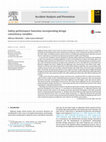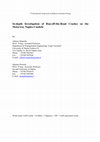Papers by alfonso montella
Sustainability, Nov 21, 2022
This article is an open access article distributed under the terms and conditions of the Creative... more This article is an open access article distributed under the terms and conditions of the Creative Commons Attribution (CC BY
Transportation Research Record, 2012
Вестник Оренбургского государственного университета, 2014
Indeed, large and highly significant crash reductions were observed following conversion of signa... more Indeed, large and highly significant crash reductions were observed following conversion of signalized and stop controlled intersections to roundabouts (Rodegerts et al., 2007b). Despite the good safety record, roundabout performance strictly depends on the design features and several issues that significantly affect both crash frequency and severity have been observed at existing roundabouts (Montella, 2007, 2011; TNZ, 2000). Indeed, in several countries official design standards and/or guidelines for roundabouts have only been developed in the last few years. Since several inconsistencies in the roundabout design practices and standards are observed, in this paper a critical review of Australasian (

Roads and bridges, Jul 1, 2002
A work zone safety audit can provide a baseline for calculating and identifying risks associated ... more A work zone safety audit can provide a baseline for calculating and identifying risks associated with proposed work zones before they are started. The audits can also portray safety issues in an area in general. It spells out the actions and preventive steps required before construction starts and ensures the client understands the implications of those actions. The audit has a client who commissions it, a designers who provides the traffic control and design information to the audit team and the independent audit team consisting of at least two people with some experience in traffic engineering and safety design. Two work zones in Naples, Italy, were audited and received failing grades for their layout and signage, including one sign that required motorists to veer into oncoming traffic. A third rural zone was evaluated and it had similar failings, but cars were traveling through at higher speeds.
Transportation Research Board 89th Annual MeetingTransportation Research Board, 2010
Intersections constitute only a small part of the overall highway system, yet intersection crashe... more Intersections constitute only a small part of the overall highway system, yet intersection crashes constitute a significant portion of the total crashes. In order to reduce crashes and increase capacity, recently many intersections have been converted into roundabouts. Despite the ...

Transport and sustainability, Apr 9, 2018
Abstract Purpose – Measures aimed at reducing intersection crashes have high potential to be cost... more Abstract Purpose – Measures aimed at reducing intersection crashes have high potential to be cost effective since intersections constitute only a small part of the overall highway system but intersection-related crashes constitute more than 50% of all crashes in urban areas and over 30% in rural areas. Roundabouts are a proven safety countermeasure, but several issues that significantly affect both crash frequency and severity have been observed at both existing and new roundabouts. This chapter aims to provide guidance on roundabout selection and design criteria. Methodology – The chapter first describes the most relevant criteria to be considered for choosing a roundabout. Then, after the explanation of the roundabout design process and a clear description of the roundabout classification, the chapter provides recommendations for all the steps of the geometric design, highlighting the main design features that contribute to the best safety performances, including speed control and sight distance checks. Finally, the chapter explains traffic control devices and facilities for pedestrians and cyclists. Findings – Roundabout design needs to balance opposing demands and it is important to adopt a performance-based design approach within an iterative process. The most important performance check is the analysis of vehicle speeds through the roundabout, since achieving appropriate vehicular speeds has a very positive safety effect.

Real world crash data play a vital part in the development of safer transport since information o... more Real world crash data play a vital part in the development of safer transport since information on crash data is essential as a means of understanding where and why crashes occurred in the past and how the occurrence of similar events may be prevented in the future. Crash databases provide the basic information for effective highway safety management but several existing databases show significant drawbacks which hinder their effective use for safety analysis and improvement. In Italy, the national crash database is maintained by the National Institute of Statistics (ISTAT) and presents major issues related to the crash report form, the crash classification, the crash location, and the crash severity. Moreover, almost all police departments use an out-of-date paper form, not in line with the national and international needs. Modern technologies offer potential for significant improvements of existing methods and procedures for crash data collection, processing and analysis. To address these issues, in this paper we present the development and evaluation of a web-based platform-independent software for crash data collection, processing and analysis named ReGIS (Crash Data Collection, Processing and Analysis). The software is designed for mobile and desktop electronic devices and enables a guided and automated drafting of the crash report, assisting police officers both on-site and in the office. The software development was based both on the detailed critical review of existing Australasian, EU, and U.S. crash databases and software as well as on the continuous consultation with the stakeholders. The evaluation was carried out comparing the completeness, timeliness, and accuracy of crash data before and after the use of the software in the city of Vico Equense, in south of Italy showing significant advantages. The amount of collected information increased from 82 variables to 268 variables, i.e., a 227% increase. The time saving was more than one hour per crash, i.e., a 36% reduction. The on-site data collection did not produce time saving, however this is a temporary weakness that will be annihilated very soon in the future after officers are more acquainted with the software. The phase of evaluation, processing and analysis carried out in the office was dramatically shortened, i.e., a 69% reduction. Another benefit was the standardization which allowed fast and consistent data analysis and evaluation. Even if all these benefits are remarkable, the most valuable benefit of the new procedure was the reduction of the police officers mistakes during the manual operations of survey and data evaluation. Because of these benefits, the satisfaction questionnaires administrated to the police officers after the testing phase showed very good acceptance of the procedure.

Accident Analysis & Prevention, Mar 1, 2010
The identification of crash hotspots is the first step of the highway safety management process. ... more The identification of crash hotspots is the first step of the highway safety management process. Errors in hotspot identification may result in the inefficient use of resources for safety improvements and may reduce the global effectiveness of the safety management process. Despite the importance of using effective hotspot identification (HSID) methods, only a few researchers have compared the performance of various methods. In this research, seven commonly applied HSID methods were compared against four robust and informative quantitative evaluation criteria. The following HSID methods were compared: crash frequency (CF), equivalent property damage only (EPDO) crash frequency, crash rate (CR), proportion method (P), empirical Bayes estimate of total-crash frequency (EB), empirical Bayes estimate of severe-crash frequency (EBs), and potential for improvement (PFI). The HSID methods were compared using the site consistency test, the method consistency test, the total rank differences test, and the total score test. These tests evaluate each HSID method's performance in a variety of areas, such as efficiency in identifying sites that show consistently poor safety performance, reliability in identifying the same hotspots in subsequent time periods, and ranking consistency. To evaluate the HSID methods, five years of crash data from the Italian motorway A16 were used. The quantitative evaluation tests showed that the EB method performs better than the other HSID methods. Test results highlight that the EB method is the most consistent and reliable method for identifying priority investigation locations. The EB expected frequency of total-crashes (EB) performed better than the EB expected frequency of severe-crashes (EBs), although the results differed only slightly when the number of identified hotspots increased. The CF method performed better than other HSID methods with more appealing theoretical arguments. In particular, the CF method performed better than the CR method. This result is quite alarming, since many agencies use the CR method. The PFI and EPDO methods were largely inconsistent. The proportion method performed worst in all of the tests. Overall, these results are consistent with the results of previous studies. The identification of engineering countermeasures that may reduce crashes was successful in all of the hotspots identified with the EB method; this finding shows that the identified hotspots can also be corrected. The advantages associated with the EB method were based on crash data from one Italian motorway, and the relative performances of HSID methods may change when using other crash data. However, the study results are very significant and are consistent with earlier findings. To further clarify the benefits of the EB method, this study should be replicated in other countries. Nevertheless, the study results, combined with previous research results, strongly suggest that the EB method should be the standard in the identification of hotspots.

Accident Analysis & Prevention, Jun 1, 2020
Methods based on crash data analysis are effective in identifying intersections with a potential ... more Methods based on crash data analysis are effective in identifying intersections with a potential for safety improvement. However, it is well recognized that crash data suffer from several shortcomings and that there are clues to safety other than crash occurrence. The systemic approach is an alternative method to address safety issues. In this approach, a transportation agency is able to identify priority locations based on the presence of risk factors rather than actual crashes. To promote wider use of the systemic safety approach, this paper aims at developing and validating a procedure to rank unsignalised urban intersections for safety improvement based on the evaluation of risk factors by road safety inspections. The procedure assesses a Safety Index (SI) that measures the safety performance of unsignalised urban intersections. The SI is formulated by combining two components of risk: the exposure of road users to road hazards (Exposure) and the risk factors, which increase the probability of involvement in crashes (Risk Index). The SI is made of two elements, one related to vehicles and one to pedestrians. Twenty-three detailed safety issues and ten general safety issues are assessed to compute the vehicle Risk Index and the pedestrian Risk Index. Safety issues were selected considering that they are common issues and that effective remedial measures exist and have already proven their effectiveness. Finally, criteria for identifying and ranking safety issues were defined. The SI has two main practical applications. High risk intersections, where safety measures that can reduce crash frequency exist, can be identified and ranked by the SI. Specific safety issues, that give more contribution to unsafety, are pointed out in order to give indication about more appropriate safety measures according to the systemic safety approach. The procedure was validated with a sample of eighty-nine urban intersections located in Orange County (Florida, U.S.). For these intersections, the SI scores, the Empirical Bayes (EB) safety estimates, and the potential for improvement (PFI) were compared. The correlation between the SI scores and the EB estimates was highly significant both for vehicles (R2 = 0.66) and pedestrians (R2 = 0.58) as well as for the total crashes (R2 = 0.68). The results from the Spearman's rank-correlation analysis provided further validation for the SI indicating that ranking from the SI and the EB estimates agree at the 99.9% confidence level for vehicles (ρs = 0.78), pedestrians (ρs = 0.93), and total (ρs = 0.93).

Accident Analysis & Prevention, Sep 1, 2019
First step of the development of an effective safety management system is to create reliable cras... more First step of the development of an effective safety management system is to create reliable crash databases since the quality of decision making in road safety depends on the quality of the data on which decisions are based. Improving crash data is a worldwide priority, as highlighted in the Global Plan for the Decade of Action for Road Safety adopted by the United Nations, which recognizes that the overall goal of the plan will be attained improving the quality of data collection at the national, regional and global levels. Crash databases provide the basic information for effective highway safety efforts at any level of government, but lack of uniformity among countries and among the different jurisdictions in the same country is observed. Several existing databases show significant drawbacks which hinder their effective use for safety analysis and improvement. Furthermore, modern technologies offer great potential for significant improvements of existing methods and procedures for crash data collection, processing and analysis. To address these issues, in this paper we present the development and evaluation of a web-based platformindependent software for crash data collection, processing and analysis. The software is designed for mobile and desktop electronic devices and enables a guided and automated drafting of the crash report, assisting police officers both on-site and in the office. The software development was based both on the detailed critical review of existing Australasian, EU, and U.S. crash databases and software as well as on the continuous consultation with the stakeholders. The evaluation was carried out comparing the completeness, timeliness, and accuracy of crash data before and after the use of the software in the city of Vico Equense, in south of Italy showing significant advantages. The amount of collected information increased from 82 variables to 268 variables, i.e., a 227% increase. The time saving was more than one hour per crash, i.e., a 36% reduction. The on-site data collection did not produce time saving, however this is a temporary weakness that will be annihilated very soon in the future after officers are more acquainted with the software. The phase of evaluation, processing and analysis carried out in the office was dramatically shortened, i.e., a 69% reduction. Another benefit was the standardization which allowed fast and consistent data analysis and evaluation. Even if all these benefits are remarkable, the most valuable benefit of the new procedure was the reduction of the police officers mistakes during the manual operations of survey and data evaluation. Because of these benefits, the satisfaction questionnaires administrated to the police officers after the testing phase showed very good acceptance of the procedure.

Transportation Research Record, 2007
The number of roundabout intersections is quickly increasing around the world, mainly because of ... more The number of roundabout intersections is quickly increasing around the world, mainly because of their good safety performance. However, roundabout performance can be degraded if precautions are not taken during either the design or the operation phase. Safety review methodologies are well suited for roundabout analysis, but their effectiveness can be improved substantially if the review recommendations are supported by a quantitative safety assessment. A roundabout safety assessment procedure is presented. Validation of the safety assessment procedure was carried out by a comparison of the results with empirical Bayes (EB) safety estimates. From the procedure, a safety index (SI) for roundabout approaches and for the whole number of roundabouts is assessed. The SI was assessed for 55 approaches of 15 urban roundabouts in Italy. For approaches, the correlation between the SI values and the EB safety estimates is highly significant (t = 15.62, p-value < 0.001), with 83% of the variation in the estimated number of crashes explained by the SI value. For all roundabouts, the correlation between SI values and EB safety estimates remains highly significant (t = 14.27, p-value < 0.001), with 94% of the variation in the estimated number of crashes explained by the SI value. The SI procedure makes it possible to support review recommendations by a quantitative safety evaluation. The SI can be used to rank both roundabouts and roundabout approaches by priority according to potential crash reduction from the safety measures. Furthermore, the SI procedure allows detection of safety issues that contribute the most to safety problems.
Transportation Research Record, 2005
Safety reviews of existing roads are becoming an accepted practice in many agencies around the wo... more Safety reviews of existing roads are becoming an accepted practice in many agencies around the world. These reviews can be highly cost-effective, but the subjective nature of the process can give rise to inconsistencies that limit their effectiveness. To address this issue, a ...
Transportation Research Record, 2009

Detection and classification of distresses is a fundamental activity in the road pavement managem... more Detection and classification of distresses is a fundamental activity in the road pavement management. Even in the early stages of deterioration, road pavement needs to be monitored to identify problems, evaluating the actual conditions and predicting what the future conditions will be. Monitoring activities through manual/visual inspections are time consuming, costly and cause of safety concerns. For these reasons, distress identification is usually limited to few sections randomly selected. The introduction of new high efficiency equipment for distress detection and classification is opening new perspective in road pavement analysis and management. Automatic pavement monitoring and Mechanistic design are introducing new pavement performance indicators and criteria for distress classification. Previous studies show lack of correlations between indexes derived from manual and automatic pavement monitoring. Therefore, capability to derive manual distress parameters from automatic monitoring systems is of great interest in the definition and testing of criteria and methodological approaches. In this paper, a background is reported by referencing examples of North American and Italian tests for the detection and classification of distresses from manual survey and capabilities of the state-of-the-art Automatic Road Analyzer (ARAN 9000) as well. An infield experiment and calibration of a Probabilistic Neural Network Classifier is presented for deriving distress measures from automatic systems.

Accident Analysis & Prevention, 2015
Highway design which ensures that successive elements are coordinated in such a way as to produce... more Highway design which ensures that successive elements are coordinated in such a way as to produce harmonious and homogeneous driver performances along the road is considered consistent and safe. On the other hand, an alignment which requires drivers to handle high speed gradients and does not meet drivers' expectancy is considered inconsistent and produces higher crash frequency. To increase the usefulness and the reliability of existing safety performance functions and contribute to solve inconsistencies of existing highways as well as inconsistencies arising in the design phase, we developed safety performance functions for rural motorways that incorporate design consistency measures. Since the design consistency variables were used only for curves, two different sets of models were fitted for tangents and curves. Models for the following crash characteristics were fitted: total, singlevehicle runoff the road , other single vehicle, multi vehicle, daytime, nighttime, non-rainy weather, rainy weather, dry pavement, wet pavement, property damage only, slight injury, and severe injury (including fatal). The design consistency parameters in this study are based on operating speed models developed through an instrumented vehicle equipped with a GPS continuous speed tracking from a field experiment conducted on the same motorway where the safety performance functions were fitted (motorway A16 in Italy). Study results show that geometric design consistency has a significant effect on safety of rural motorways. Previous studies on the relationship between geometric design consistency and crash frequency focused on two-lane rural highways since these highways have the higher crash rates and are generally characterized by considerable inconsistencies. Our study clearly highlights that the achievement of proper geometric design consistency is a key design element also on motorways because of the safety consequences of design inconsistencies. The design consistency measures which are significant explanatory variables of the safety performance functions developed in this study are: (1) consistency in driving dynamics, i.e., difference between side friction assumed with respect to the design speed and side friction demanded at the 85th percentile speed; (2) operating speed consistency, i.e., absolute value of the 85th percentile speed reduction through successive elements of the road; (3) inertial speed consistency, i.e., difference between the operating speed in the curve and the average operating speed along the 5 km preceding the beginning of the curve; and (4) length of tangent preceding the curve (only for runoff the road crashes).

Transportation Research Board 92nd Annual MeetingTransportation Research Board, 2013
The use of roundabouts improves intersection safety by eliminating or altering conflict types, re... more The use of roundabouts improves intersection safety by eliminating or altering conflict types, reducing crash severity, and causing drivers to reduce speeds. However, previous studies have showed that poor geometric design can be a major contributory factor in crashes at roundabouts. Poor geometric design can result from inconsistencies in geometric design standard or the lack of standards. With the growing number of roundabouts internationally, several countries have recently updated their standards and guidelines. A review of the Australasian, EU and US standards and guidelines showed several inconsistencies within the Italian roundabout standard (and the standards used by other countries). Several recommendations for improvement of the Italian standard have been proposed. These recommendations are mainly based on the concepts of design flexibility and performance based design. Indeed, rigid standards, which do not really take into account safety and operational consequences of the design decisions, and the need to balance opposing demands might produce undesirable outcomes. Finally, the authors would like to highlight the need for further research on the relationships between roundabout geometric design criteria, drivers’ behavior and safety.
Traffic Safety on Two ContinentsPTRC Education and Research Services Limited, 2000
Abstract: Although run off the road accidents frequently occur on horizontal curves, the performa... more Abstract: Although run off the road accidents frequently occur on horizontal curves, the performances of the safety barriers are evaluated by full scale crash tests which are performed on rectilinear safety barriers and no one study aimed at evaluating the safety barriers behavior on curves has been done. In this paper, the results of a study aimed at evaluating the dynamics and the outcomes of the collision of heavy goods vehicles against road safety barriers on horizontal curves are reported. The study was carried out by a ...

3rd International Conference on Road Safety and SimulationPurdue UniversityTransportation Research Board, 2011
In this study, a decision supporting system based on the identification and quantitative evaluati... more In this study, a decision supporting system based on the identification and quantitative evaluation of the crash scenarios in the road network in order to implement the most cost effective safety measures is presented. In the paper, a concise description of the organization of the database, the formulation of the assumptions underlying the procedure, and the application of the procedure to a case study in Italy are described. Crash cases which, even if dispersed over a network or road section, present similarities in their process can lead to similar preventive measures. These crashes can then be aggregated around a crash scenario. That is, crashes at different sites which present similarities and belong to the same scenarios can be treated as unique entity. Crash scenarios are ranked according to their hazard level, and it is assumed that all the vehicles travelling the highway under the same scenario have the same crash probability. As a consequence, the benefits arising from the transformation of one scenario into another one depend on the hazard level of the two scenarios (before and after the implementation of the safety countermeasures). On this basis, if a certain financial resource is available, the choice of the scenario conversion group on a certain road network can be done searching among groups having a total cost equal to the available resources the group in which the total benefit is maximum.

In the paper, results from in-depth investigation of 1,092 run off the road (ROR) crashes on the ... more In the paper, results from in-depth investigation of 1,092 run off the road (ROR) crashes on the motorway A16 (Italy) are presented. The research is aimed at pointing out risk factors that can address highway agencies and designers toward the selection of safety countermeasures aimed at reducing ROR crashes frequency and severity. Crash data were collected trough the analysis of police crash reports and relate to the period 2001-2005. Basing on police and hospital reports, each crash was categorized in six injury levels. To determine whether a specific crash pattern of the analysis group was significantly different from that of the control group, the Chi Squared (χ 2) test with Yates' correction was performed. Severity of motorcycle crashes was significantly higher than severity of other vehicle types. In adverse environmental conditions (night time and wet pavement), crash severity was lower than in favourable conditions. Crashes against ditches, walls, foreslopes, and backslopes were more severe than crashes against roadside steel safety barriers. Comparison between severity of crashes against longitudinal safety barriers and their blunt end terminals showed a dramatic increase in crash severity against the terminals. Thrie-beam roadside barriers that meet EN 1317 performance criteria showed a smaller crash severity and a better performance compared to older W-beam roadside barriers. Median New Jersey concrete barriers, compared to median steel safety barriers, showed greater crash severity and greater proportion of rollovers, not counterbalanced by a significant better behaviour in relation to penetration and override.









Uploads
Papers by alfonso montella